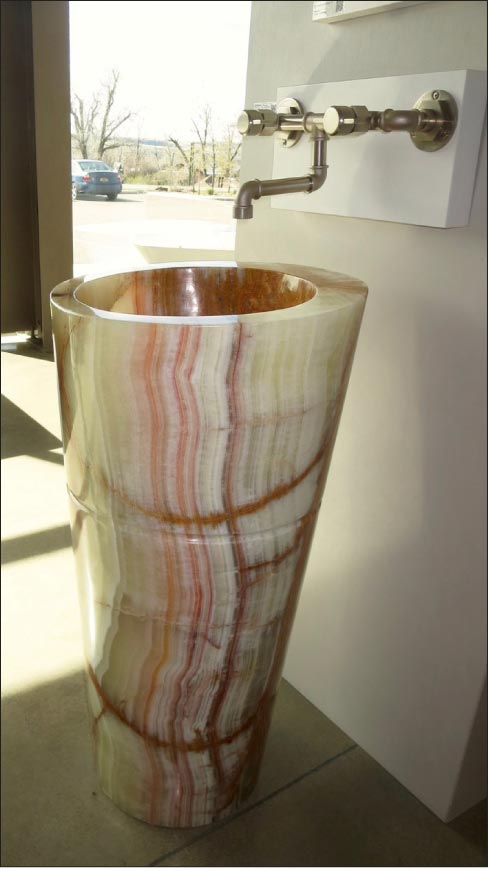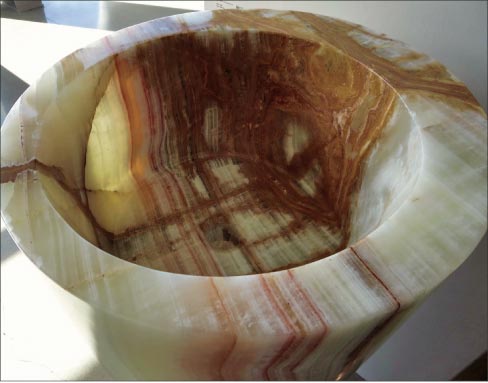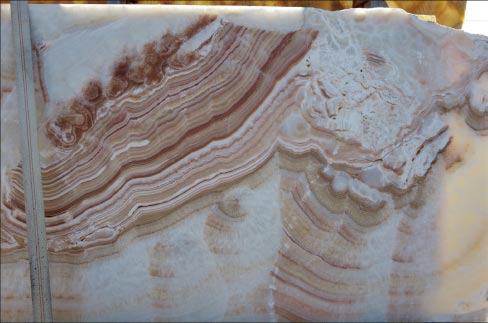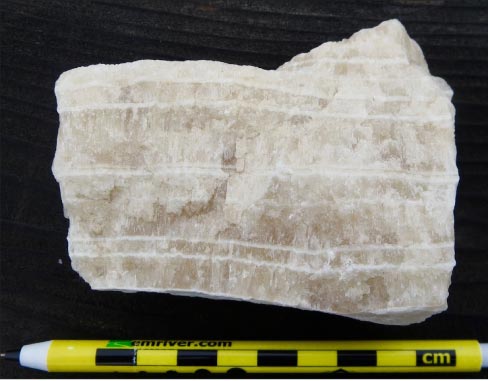The Mystique of Onyx
Karin Kirk
usenaturalstone.com
Photos © Karin Kirk
 |
|
Above: This stunning freestanding onyx sink basin makes a dramatic statement as functional sculpture. |
 |
|
Above: This onyx sink basin shows off the intriguing translucence of onyx. Backlit bars, countertops or basins can be the focal point of any room. |
 |
|
Above: This White Onyx slab beautifully illustrates the typical, intricate crystals of calcite, and iron-rich color banding. |
 |
|
Above: A sample of banded calcite, collected by the author in Montana. |
Walk in to a slab yard or stone showroom and ask to see their onyx slabs, and you are likely to get a wide-eyed response from the sales person. Oooh. Onyx. Follow me.
Onyx is the stuff of fantasy. Its sparkly translucence belies the fact that it’s solid rock. It looks like a gemstone, with wavy bands of amber, ivory, and white, fused together in a fluid pattern. When backlit, onyx radiates a soft, ethereal light. It’s truly an extraordinary stone; wherever it is used it will take center stage. There is no artist greater than our very own Earth for the sheer variety of materials and patterns we can bring into our homes.
In keeping with its magical look, onyx has a bit of mystique. It’s beautiful, but what is it?
Onyx Goes by Many Names
In the commercial stone industry, onyx refers a category of stones that are made of layered bands of light-colored or translucent minerals. Most slabs of onyx are what a geologist would call banded calcite. This same material also goes by the names onyx marble, Mexican onyx, or Egyptian alabaster. Onyx is commercially classified as a sibling to marble because these two stones have the same mineral content. Onyx is made of calcite, which is the same mineral that makes up limestone, marble, and travertine. In fact, banded calcite is a close cousin of travertine and forms in a similar way.
Onyx is a Product of Spring Water
While granite, quartzite, and marble are all forged deep within the earth’s crust, onyx is borne right on the surface. Onyx forms from spring water or groundwater that has an abundance of calcite dissolved in it. When this water emerges at the mouth of a spring, the minerals precipitate out and build a crust of calcite crystals. Over time, more water flows by and more minerals settle out. The variations between the layers are caused by differences in the water flow rate, and small amounts of impurities. In its most pure state calcite is white or clear, but it’s easily tinted by minor amounts of other minerals. The most common color of onyx is a warm honey color, which is caused by iron oxide. The flowing layers of onyx reflect subtle variations in the spring water, and add an artistic quality to the patterns and bands. Slabs of onyx are made by slicing down into the layers, revealing thousands of years of deposits.
Onyx can also form inside caves or in other openings in bedrock. Veins of banded calcite can be found in fractured limestone, or even in volcanic rocks. Basically, anywhere that mineral-laden groundwater flows, it can create beautiful formations of crystals. All it takes is the happenstance to discover the underground cache.
Travertine is formed in the same manner as onyx. The main difference between travertine and onyx is that travertine has a porous, lace-like texture while onyx is smooth and non-porous. Aside from that, the two stones are similar.
Uses of Onyx
As you may have guessed, onyx is a somewhat fragile stone. It can become scratched and etched if used in a busy kitchen. Onyx countertops are best suited to parts of a kitchen that don’t see much heavy use. High-end restaurants and resorts employ onyx bar tops to bring brilliance into a space, an effect that is made even more spectacular when the stone is backlit. Onyx is also used as a backsplash, vanity, or as accent tiles.
Onyx isn’t limited to slabs though. It can be formed into basins, lighting fixtures, or tabletops. One of the most extraordinary qualities of onyx is its ability to radiate light. Any application that takes advantage of this quality is sure to make a beautiful statement.
Even though onyx can’t be used everywhere, its appeal is universal. This stone will tug at your heartstrings. Few of us can pass it by without pausing to admire the patterns and plays of light. Onyx reminds us that natural materials are unparalleled in their artistry. In this case, the stone is a collaboration of three simple ingredients: water, minerals, and time.
Karin Kirk is a geologist and science educator with over 20 years of experience. She has taught college level geology, online courses and organized field trips. She currently works as a freelance science writer and education consultant. She brings with her a different perspective to the stone industry. Karin most recently presented a program at TISE 2017.